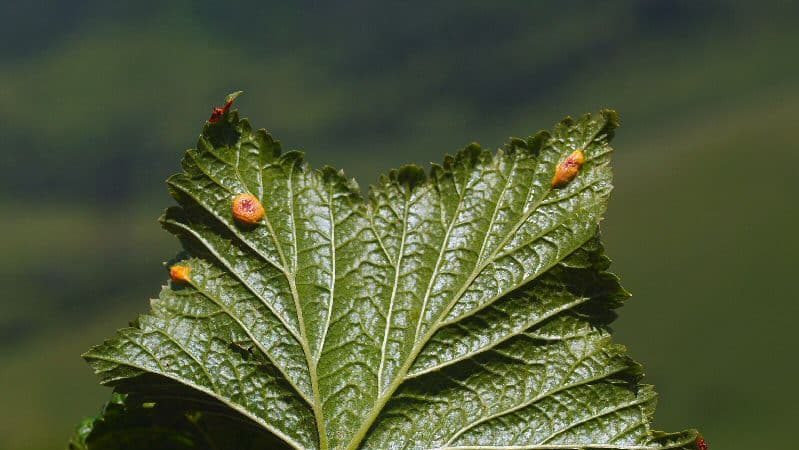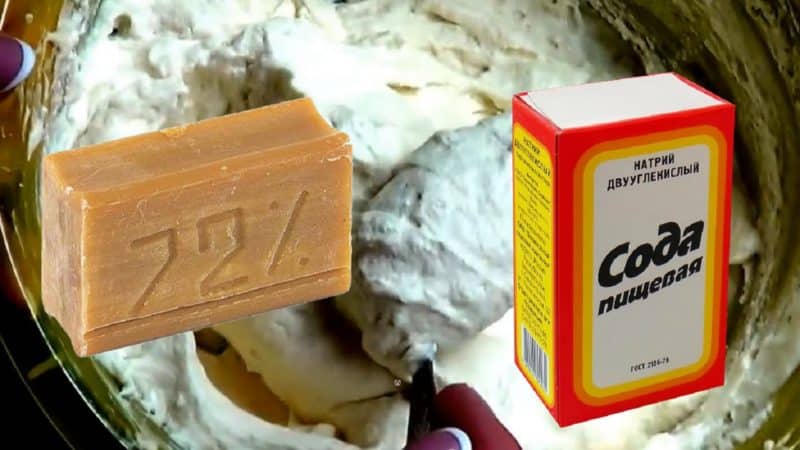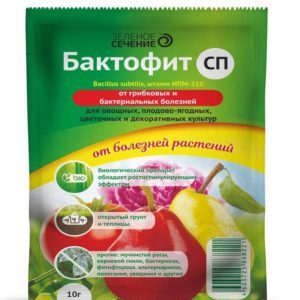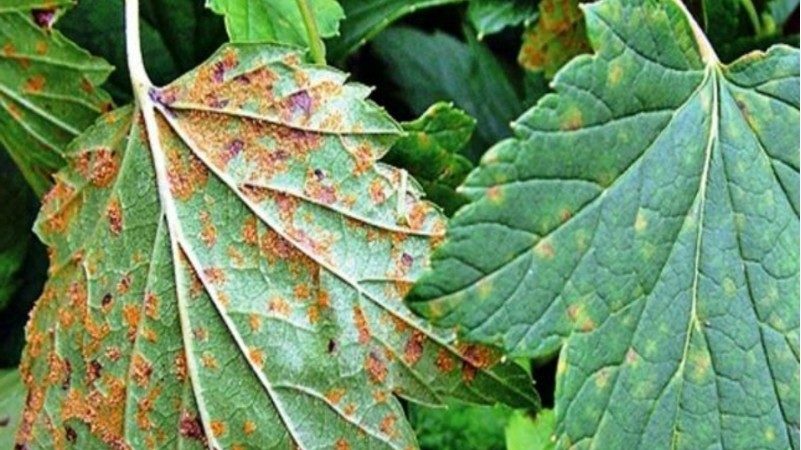How to deal with rust on currants and prevent its occurrence
Currants are one of the most unpretentious and hardy garden plants. Black, red and white varieties of this crop can grow in all regions of our country. It is not demanding in terms of care and is capable of producing a harvest even with minimal attention from the gardener. However, without protection from diseases and pests, the bush often dies.
The most common and dangerous disease of currants is rust. It often affects crops and causes leaves, shoots and berries to fall off. Without timely treatment, the bush dies. We will tell you further how to deal with rust on currants and prevent its occurrence.
Types of rust on currants and their symptoms
The causative agent of rust is a fungal infection. There are many varieties of fungi that can cause orange spots to appear on leaves. Currants are affected by goblet and columnar rust.
These types of rust have different symptoms. However, the treatment will be the same regardless of the type of pathogen.

glass-shaped
Goblet rust is caused by the fungus Puccinia ribesicaricis. Infection occurs in early spring. The fungus settles on the underside of the leaf blade and then spreads throughout the plant. At the beginning of development, it is difficult to detect the disease. The leaves begin to rust in early June and fall off in mid-summer.
Signs of the disease:
- Orange dots appear on the underside of the leaf blade.They are usually located along the veins. Over time, the dots become voluminous and increase in size. By mid-summer, they transform into glass-shaped red growths, from which rusty powder pours out. The growths darken, increase in size and grow.
- The outer side of the leaf is covered with yellow depressed spots. Gradually they merge and the entire leaf turns yellow.
- The leaves become stiffer, turn brown, bend and become deformed. They feel furry to the touch.
- Young shoots stop developing, curl and dry out.
- The disease spreads to the formed ovaries. Infected berries become covered with a white coating and become inedible.
Columnar
Columnar rust is caused by a fungus of the genus Cronartium ribicola Dietr. The infection attacks the underside of the leaf blade and spreads throughout the plant.
Symptoms of the disease:
- Light yellow spots of irregular shape appear on the outside of the leaf. The pattern of them resembles a mosaic. Later, the spots acquire an orange tint.
- Where there were spots on the outside of the leaf plate, convex growths in the form of spots and stripes form over time on the inside of the leaf. They have a yellowish tint and begin to rust and darken over time. By the end of the growing season, curved nipple-shaped (columnar) formations of reddish-brown color grow on the spots, which consist of many tiny spores and hang from the leaves. The leaves begin to curl and dry out.
- Often disease spreads to branches, ovaries and shoots. The affected areas also first become covered with spots, and then with hanging columnar formations.
The first signs of the disease become noticeable in the middle of the plant's growing season.Rusty spores grow in late summer or early autumn.
This is interesting! The homeland of glass rust is Siberia. It was from there that it spread throughout Europe.
Causes of rust

The reasons for the development of rust and its entry onto the site lie in maintenance errors and factors beyond human control. Why does it occur:
- Proximity of coniferous plants. It is coniferous plants (including juniper) that transmit columnar rust.
- Weeds. The intermediate host of goblet rust is sedge and other marsh plants.
- Last year's foliage and plant residues are where the fungus overwinters.
- Pests. They not only eat the plant, reducing its immunity, but also spread fungal infections. Such pests include spider mites, currant gall midges and aphids.
- Planting currants in wetlands and places with close groundwater. Increased soil moisture is an ideal condition for the development of fungal infections.
- Prolonged precipitation. High humidity combined with low air temperature weakens plant immunity and promotes fungal infection.
The fungus spreads across the area by the wind. There is a high risk of infection if there are intermediate hosts or diseased plants in the garden.
How dangerous is the disease?
Rust not only makes the currant bush aesthetically unattractive and the leaves unsuitable for use in conservation, but also threatens the life of the plant. The harm this disease causes:
- Loss of harvest. Few ovaries are formed on a diseased plant. Many of them fall off. Fruits affected by the fungus, which have already formed, become unsuitable for consumption.
- Violation of photosynthesis stops plant development.
- Falling of up to 50% of leaves. Often young shoots also fall off.
- Decreased cold resistance - the currant bush may not survive the winter.
- Decreased immunity. Currants become susceptible to other diseases.
Without treatment, flex remains on the plant for several years. As a result, the currant dies.
Fighting methods

It is not difficult to treat rust at the beginning of its development. If you notice signs of the disease in a timely manner, the disease will not cause serious damage to the plant, and it will survive the winter.
In the later stages, the disease can also be treated, but it will not be possible to try the harvest this year. For the winter, a plant that has suffered rust is covered with spunbond and snow.
Agrotechnical techniques
Agrotechnical measures to combat currant rust are the basis for treating the disease. However, they are only effective in combination with antifungal agents.
In order for the treatment to be successful, the leaves and shoots of the currant are examined. Particular attention is paid to the underside of the sheet plate.
All affected areas of the plant are removed, taken away from the site and burned. The cut areas are lubricated with garden varnish.
Weeds, fallen leaves and other plant debris around the infected bush are removed. The soil is being dug up.
Attention! The problem with using only agricultural techniques is that even if all the affected parts are removed from the bush, fungal spores will most likely end up on healthy leaves and shoots. In this case, a relapse of the disease will occur. If you use only medicinal products without removing the diseased parts of the currant, the fight will be long. In this case, relapses cannot be avoided either.
Traditional methods
Folk remedies for treating rust are considered the safest.They do not harm the environment or humans; they are used even during the fruiting period and before harvesting. But they are less effective than chemical drugs, so they are used at the beginning of the development of the disease.
What to do if currants are infected with rust:
- Soap with soda. 0.5 pieces of grated laundry soap and 120 g of soda are diluted in 10 liters of water. The product is stirred until all ingredients are dissolved. Spray the bushes and the soil around them.

- Onion-garlic infusion. 0.5 kg of garlic and 0.5 kg of onion are ground in a meat grinder along with the husks. The resulting slurry is poured with 10 liters of water and left to infuse for 2 days. The infusion is then filtered and used to spray plants.
- Manure. 1 kg of manure is diluted with 2 liters of water. The mixture is infused in a warm place for a week. Then diluted with water in a ratio of 1:10 and used to spray currant bushes.
- Fermented milk product with iodine. Pour 1 liter of kefir, whey or sour milk and 40 drops of iodine into a 10 liter bucket. The remaining volume is filled with water at room temperature.
Biological products
Biological products are prepared on the basis of microorganisms that do not harm plants, but destroy fungus. They are not dangerous to humans, the environment and animals, which is why most gardeners prefer to use them.
Biological products to combat rust:

- "Glyocladin." It is made from a fungus that has a depressing effect on other microorganisms.
- "Trichoderma veride" It is made on the basis of fungi that penetrate the mycelium of the pathogen and destroy it.
- "Baktofit". The composition contains bacteria that inhibit the effect of fungal infections.
- "Sporobacterin". Effective against goblet and columnar rust.
- "Fitosporin-M". The most popular biological product.The main active ingredient is a bacterium that is effective against most fungi that cause currant diseases.
The main advantage of biological products is that they not only help cope with the infection, but also increase the plant’s immunity and also stimulate growth. The disadvantage of such remedies is that they do not work against all diseases.
Chemicals
Chemical agents are most effective in treating rust. They quickly destroy the fungus, are not washed off by rain and protect currants from re-infection for 2-3 weeks after application. They help cope with the disease even at a late stage.
The disadvantage of such drugs is toxicity. They are harmful to humans, the environment and animals. If you treat the bush During the flowering or fruiting period, the harvest from it cannot be eaten.
Chemicals are used in spring before flowering or after harvest. If other means do not help, you can process the currants at any time, but then you will have to be left without a harvest this year.
Note! Fungicides are not washed away by rain. Therefore, re-treatment after each precipitation is not required.
How to treat rusty leaves:
- "Previkur". A systemic fungicide is absorbed into plant cells, making it toxic to fungi. The solution is prepared immediately before treatment. To do this, take 7.5 ml of product per 5 liters of water. “Previkur” is first diluted in a small amount of water, then poured into the rest of the liquid.
- "Skor." The contact fungicide acts directly on the fungal infection, but after 3 procedures it becomes addictive. To prepare a solution, dilute 1 ml of the drug in 10 liters of water.The treatment is carried out at a temperature not lower than +15°C, since in cooler weather the effectiveness of the product decreases.
- "Topaz". A systemic fungicide stops the development of the fungus and its spores. It is not washed off by rain and continues to work for 14 days after application. It is considered a relatively safe fungicide. To prepare the mixture for spraying, dissolve 2 ml of the product in 10 liters of water.
- Copper sulfate also applies to fungicides. In addition, it has the properties fertilizers. You can spray currants with it not only before flowering, but also 2 weeks before harvest. The product should not be used during flowering.

- Bordeaux mixture withIt consists of copper sulfate and slaked lime. Suitable for prevention and treatment. For 10 liters of water take 2 tsp. drug.
How to deal with rust correctly
To cope with rust, it is important not only to choose the right product, but also to use it correctly:
- Before treatment, remove all diseased parts of the plant.
- Spraying the bush is carried out in the morning or evening, when the sun is inactive, so that burns do not appear on the leaves.
- When preparing the drug, the proportions are observed. Otherwise, there will also be burns on the plant.
- When treating a bush for rust, all its parts are generously sprayed. Particular attention is paid to the underside of the sheet.
- They treat not only the bush, but also the soil around it.
- Spray with fungicides no later than 2 hours before precipitation. Chemicals are applied to diseased currants at least 2-3 times. The intervals between application of drugs are 2-3 weeks.
- Biological products are applied to the plant a day before precipitation. The treatment is repeated 2-3 times. The interval between sprayings is from 7 to 14 days.
- Folk remedies are washed off by rain, so after precipitation, repeat spraying is carried out. The interval between treatments is 5-7 days.
Preventive measures

Treating rust and eliminating its consequences is much more difficult than preventing the disease. Basic rules of prevention:
- In autumn, fallen leaves and plant debris are removed. The soil is being dug up.
- Weeds around the currants are removed.
- The area where currants grow should not be swampy or located where groundwater is located close to the surface. It is not recommended to plant shrubs near coniferous forests.
- In the spring, before flowering, currants are doused with boiling water. After this, spray with a solution of copper sulfate.
- After prolonged precipitation, preventive treatment is carried out. Use biological products or folk remedies.
Currant varieties resistant to rust
To avoid the problem of rust on currants, choose varieties with resistance to this disease:
- Yoshta;
- Grace;
- Zoya;
- Dove;
- Minsk;
- Belarusian sweet;
- Black veil;
- Primorsky champion.
Conclusion
Currant rust is a dangerous disease that often causes the death of the plant. There are two types of the disease, but regardless of the pathogen, the treatment will be the same. For this purpose, special preparations and folk remedies are used. The main thing is to start treatment on time and follow the basic rules.